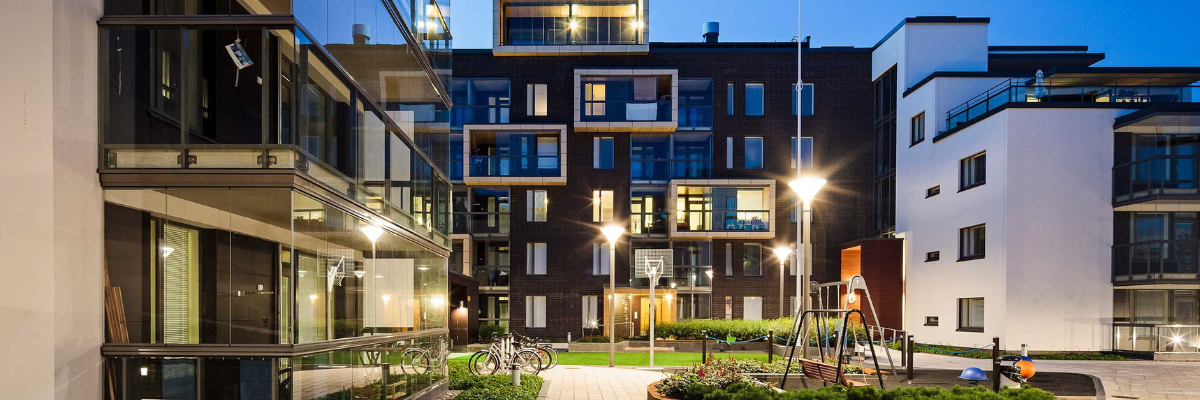
Below, we show you all the points you need to consider if you’re thinking about a glass curtain wall for your home. Read our tips closely so you get the ideal wall with all the appropriate documentation, licences and permits.
Índice de contenidos
In demand walls
There are a lot of different walls on the market for different types of spaces, including aluminium, polycarbonate and wood, to name just a few. However, the one material revolutionizing the market and the source of endless discussion is glass.
These types of walls are currently in vogue because they are designed to achieve total insulation and provide climate control to a space. This option allows for hinged walls making the chosen space very versatile.
They are suitable for all types of spaces, both indoors and outdoors, and are known as “invisible walls”. There’s no doubt that glass curtain walls are here to stay.
How about you? Do you have any questions about the regulations covering this type of glass wall? If so, you’ll be interested to know that the Horizontal Property Act is designed to make your life much easier and to let you enjoy protected outdoor spaces.
We recommend: What should the minimum distance be between my air conditioning unit and my neighbour’s window?
What does the law say about glass curtain walls on buildings and facades?
The Horizontal Property Act governs terrace enclosures, awning placement and all the other elements that affect the appearance of a building’s facade. The law also explains that enclosures and awnings must always have the full consent of the communities of owners. To avoid problems, we recommend speaking to your neighbours to reach an agreement that benefits everyone.
Obtaining the consent of the rest of the community of owners and the local council is mandatory. This consent is essential when obtaining the relevant building permit for the walls.
If you don’t get consent, you run the risk of having problems with your local government or the community of owners. In the most extreme cases, you could be asked to remove the glass curtain wall and pay a financial penalty.
Do glass curtain walls need the approval of the owners’ meeting?
The solutions for glass curtain walls are not always uniform and depend on where you live. Some councils do not consider these structures to be walls. On the other hand, some institutions see them as having the characteristics of walls, for which council authorisation is required. We recommend analysing each case thoroughly to choose the best solution.
As these structures are still new to the market, the Horizontal Property Act does not draw a distinction between traditional walls and the new glass curtain walls.
As a solution, we recommend that you adopt the following guidelines:
- Ask an experienced architect about the feasibility of the type of work you want to carry out.
- Tell your community president that you are thinking of installing one of these structures.
- Check whether the bylaws allow these structures and that they are authorised.
- Ask the council if they (and their technical department) consider these structures to be walls.
- Pass the information you receive on to the owners’ meeting.
- Article 10,3, section b, of the Horizontal Property Act applies. This establishes that local government authorisation and a three-fifths majority vote of residents is required. This means three-fifths of the holdings in the community, which requires an owners’ meeting.
- Any absent owners will have 30 days following the meeting date to indicate whether they oppose the wall.
The first thing you need is the relevant council permit. Even if the residents approve the wall, you cannot install one without a permit. Once you have the council permits, you need to discuss the wall at an owners’ meeting.
We recommend: Can I install an awning in a community of owners?
Advantages of this type of wall
Despite being walls as such, they can be almost completely opened. This lets the enclosed space maintain the feel of an open space. These are some of the benefits of installing one of these structures in your home with all the prerequisites:
- They promote energy efficiency in your home or business. Installing them can be compared to creating a large air chamber between the outdoors and the various indoor spaces. This makes it easier to control the climate in these areas and maintain an appropriate temperature at a much lower monthly cost.
- Each panel chosen can be designed inside the house. Therefore, it’s an easy-to-clean alternative and means you don’t have to lean out of the building if you’re on an upper floor, which is a plus in terms of safety.
- You can create different temporary rooms inside, thanks to the modular options and offerings. For example, you can use partitions to create your own office in the home. And when you open the partitions up, the office is transformed into a meeting room. It’s a practical opportunity to make the best use of the space.
- They are a great way to optimise the existing light outdoors, and especially indoors. Because they are transparent, as partitions they provide all the advantages of a wall but without losing any light.
As you’ve seen, glass curtain walls need to be approved by your community of owners, except when they don’t require installation work. However, they always require a council permit. In some situations, it is stipulated that connected structures do not affect the safety of the building, structure, layout or exterior. Whether or not this applies in your case, the structure must always be installed in a way that does not negatively affect any other resident in any way.